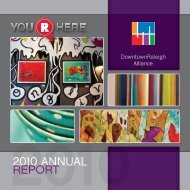Pedestrian Count Study - Downtown Raleigh Alliance
Pedestrian Count Study - Downtown Raleigh Alliance
Pedestrian Count Study - Downtown Raleigh Alliance
You also want an ePaper? Increase the reach of your titles
YUMPU automatically turns print PDFs into web optimized ePapers that Google loves.
1. Executive Summary<br />
1.1 Purpose<br />
The <strong>Downtown</strong> <strong>Raleigh</strong> <strong>Alliance</strong> (DRA) commissioned this study of<br />
pedestrian activity in key downtown corridors as a means of furthering<br />
the downtown’s economic development goals. The three target areas<br />
of the study are: the Fayetteville District, Glenwood South District, and<br />
Warehouse District. Through use of the pedestrian count methodology<br />
described below, this report establishes a baseline of current pedestrian<br />
activity in <strong>Raleigh</strong>’s downtown core and late night/entertainment districts.<br />
The analysis of current pedestrian activity provided in this report allows<br />
both the DRA and the City to better understand pedestrian preferences,<br />
evaluate pedestrian infrastructure, and anticipate the future needs,<br />
as well as contributions of downtown pedestrians. Economically, the<br />
count data will support local efforts to attract new and expanded retail,<br />
restaurants, and commercial occupants, each of which bears a unique<br />
relationship to pedestrian activity in terms of peak periods of activity,<br />
location, and visibility.<br />
This pedestrian count also contributes to the broader vision of promoting<br />
downtown <strong>Raleigh</strong> as a regional center of commerce, tourism, and<br />
livability. Walkable streetscapes are a cornerstone of a thriving downtown<br />
and a growing urban economy. With the fi ndings of this report and<br />
continued focus on the nature of pedestrian activity in priority areas,<br />
downtown <strong>Raleigh</strong> can offer compelling evidence of the strength and<br />
appeal of its urban core.<br />
1.2 Methodology<br />
This study employs a nationally-vetted pedestrian count methodology<br />
created by the National Bicycle and <strong>Pedestrian</strong> Documentation project<br />
(NBPD). The forms, metrics, and implementation strategies are derived<br />
from this proven national system of recording bike and pedestrian activity.<br />
Within the three priority districts of downtown, the <strong>Downtown</strong> <strong>Raleigh</strong><br />
<strong>Alliance</strong> identifi ed 74 count locations. Each of the 74 locations specifi es<br />
a specifi c side of the selected street within a specifi c block. <strong>Count</strong>s<br />
were taken at a mid-block point, using the “screenline” approach,<br />
which essentially ensures that each “body on the sidewalk” that passes<br />
through an imaginary straight-line screen is counted. As determined by<br />
the national methodologies, this approach provides consistency and<br />
reliability.<br />
Over the course of four weeks during springtime weather, counts were<br />
taken on eight weekdays and one Saturday. The counts also varied<br />
by specifi c time of day to capture pedestrian activity throughout a<br />
“typical” day in downtown <strong>Raleigh</strong>. In particular, recognizing tendencies<br />
of downtown commercial activity, this report focused on a morning<br />
timeframe, the lunchtime period, the afternoon peak, and also late-night<br />
activity.<br />
<strong>Pedestrian</strong> <strong>Study</strong> | Executive Summary-1.3<br />
mary







